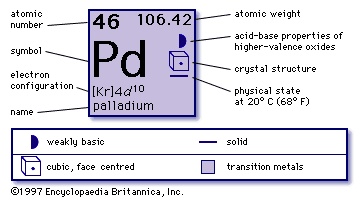palladium
chemical element
 chemical element, least dense and lowest-melting of the platinum metals (platinum group) of Groups 8–10 (VIIIb), Periods 5 and 6, of the periodic table, used especially as a catalyst (a substance that speeds up chemical reactions without changing their products) and in alloys. A precious, gray-white metal, palladium is extremely ductile and easily worked. Palladium is not tarnished by the atmosphere at ordinary temperatures. Thus, the metal and its alloys serve as substitutes for platinum in jewelry and in electrical contacts; the beaten leaf is used for decorative purposes. Relatively small amounts of palladium alloyed with gold yield the best white gold. Palladium is used also in dental alloys. The largest use of the pure metal is for electrical contacts in telephone equipment. Palladium coatings, electrodeposited or chemically plated, have been used in printed-circuit components.
chemical element, least dense and lowest-melting of the platinum metals (platinum group) of Groups 8–10 (VIIIb), Periods 5 and 6, of the periodic table, used especially as a catalyst (a substance that speeds up chemical reactions without changing their products) and in alloys. A precious, gray-white metal, palladium is extremely ductile and easily worked. Palladium is not tarnished by the atmosphere at ordinary temperatures. Thus, the metal and its alloys serve as substitutes for platinum in jewelry and in electrical contacts; the beaten leaf is used for decorative purposes. Relatively small amounts of palladium alloyed with gold yield the best white gold. Palladium is used also in dental alloys. The largest use of the pure metal is for electrical contacts in telephone equipment. Palladium coatings, electrodeposited or chemically plated, have been used in printed-circuit components.Native palladium, though rare, occurs alloyed with a little platinum and iridium in Colombia (department of Chocó), in Brazil (Itabira, Minas Gerais), in the Ural Mountains, and in South Africa (the Transvaal). Palladium is one of the most abundant platinum metals and occurs in the Earth's crust at an abundance of 0.015 parts per million. For the mineralogical properties of palladium, see native element (table). Palladium also occurs alloyed with native platinum. It was first isolated (1803) from crude platinum by the English chemist and physicist William Hyde Wollaston (Wollaston, William Hyde). He named the element in honour of the newly discovered asteroid Pallas. Palladium is also associated with a number of gold, silver, copper and nickel ores. It is generally produced commercially as a by-product in the refining of copper, and nickel ores.
Surfaces of palladium are excellent catalysts for chemical reactions involving hydrogen and oxygen, such as the hydrogenation of unsaturated organic compounds. Under suitable conditions (80° C and 1 atmosphere), palladium absorbs more than 900 times its own volume of hydrogen; it expands and becomes harder, stronger, and less ductile in the process. The absorption also causes both the electrical conductivity and magnetic susceptibility to decrease. A metallic or alloylike hydride is formed from which the hydrogen can be removed by increased temperature and reduced pressure. Because hydrogen passes rapidly through the metal at high temperatures, heated palladium tubes impervious to other gases function as semipermeable membranes and are used to pass hydrogen in and out of closed gas systems or for hydrogen purification.
Palladium is more reactive than the other platinum metals; for example, it is attacked more readily by acids than any of the other platinum metals. It dissolves slowly in nitric acid to give palladium nitrate, Pd(NO3)2, and with concentrated sulfuric acid it yields palladium sulfate, PdSO4∙2H2O. In its sponge form it will dissolve even in hydrochloric acid in the presence of chlorine or oxygen. It is rapidly attacked by fused alkali oxides and peroxides and also by fluorine and chlorine at about 500° C. Palladium also combines with a number of nonmetallic elements on heating, such as phosphorus, arsenic, antimony, silicon, sulfur, and selenium. A series of palladium compounds can be prepared with the +2 oxidation state; numerous compounds in the +4 state and a few in the 0 state are also known. Among the transition metals palladium has one of the strongest tendencies to form bonds with carbon. All palladium compounds are easily decomposed or reduced to the free metal. An aqueous solution of potassium tetrachloropalladate, K2PdCl4, serves as a sensitive detector for carbon monoxide or olefin gases because a black precipitate of the metal appears in the presence of exceedingly small amounts of those gases. Natural palladium consists of a mixture of six stable isotopes: palladium-102 (0.96 percent), palladium-104 (10.97 percent), palladium-105 (22.23 percent), palladium-106 (27.33 percent), palladium-108 (26.71 percent), and palladium-110 (11.81 percent).
atomic number
46
atomic weight
106.40
melting point
1,552° C (2,826° F)
boiling point
2,927° C (5,301° F)
specific gravity
11.97 (0° C)
oxidation states
+2, +4
electronic config.
【Kr】4d10
- Kamchatka
- Kamchatka Peninsula
- Kamchatka River
- kame
- Kamehameha I
- Kamehameha II
- Kamehameha III
- Kamehameha IV
- Kamehameha V
- Kamenev, Lev Borisovich
- Kamen-na-Obi
- Kamenshek, Dorothy
- Kamensk-Shakhtinsky
- Kamensk-Uralsky
- Kamerlingh Onnes, Heike
- Kamerny Theatre
- Kames, Henry Home, Lord
- kami
- kamidana
- kamikaze
- kamikaze of 1274 and 1281
- Kamina
- Kaminaljuyú
- Kaministiquia River
- Kaminska, Ida